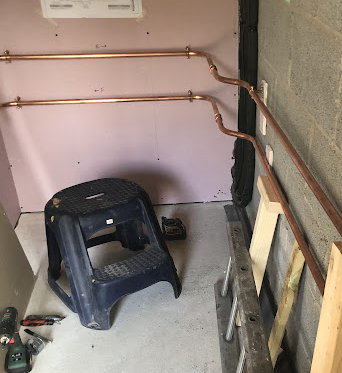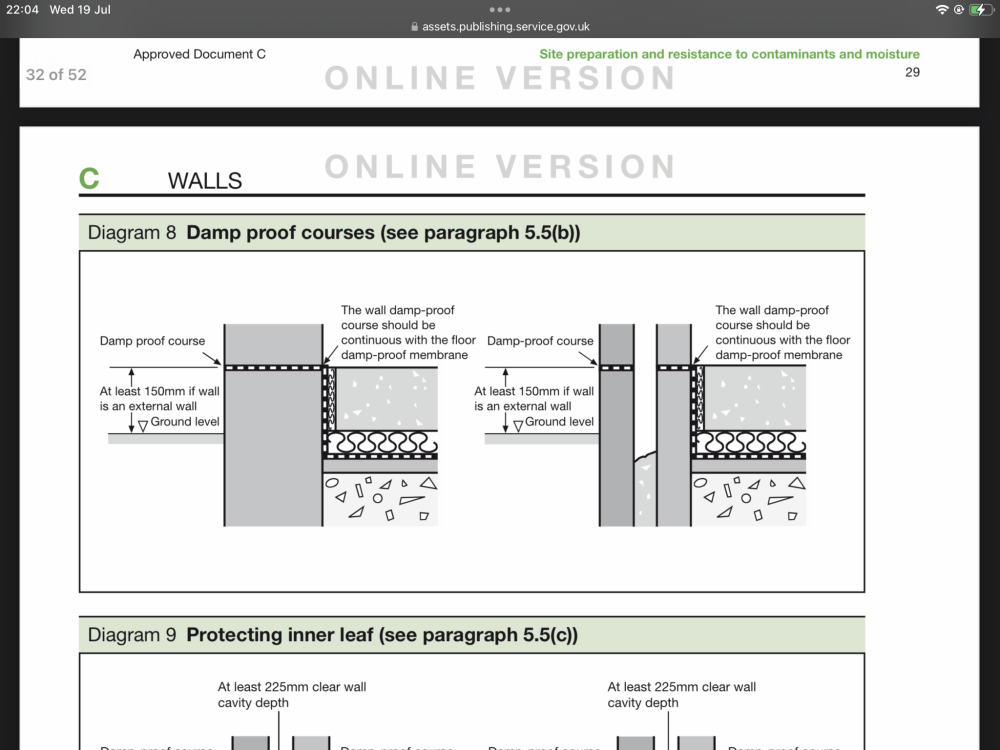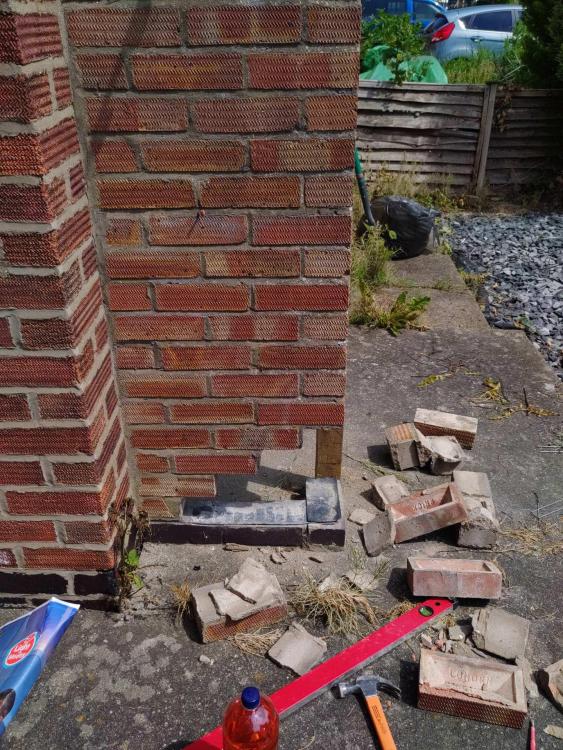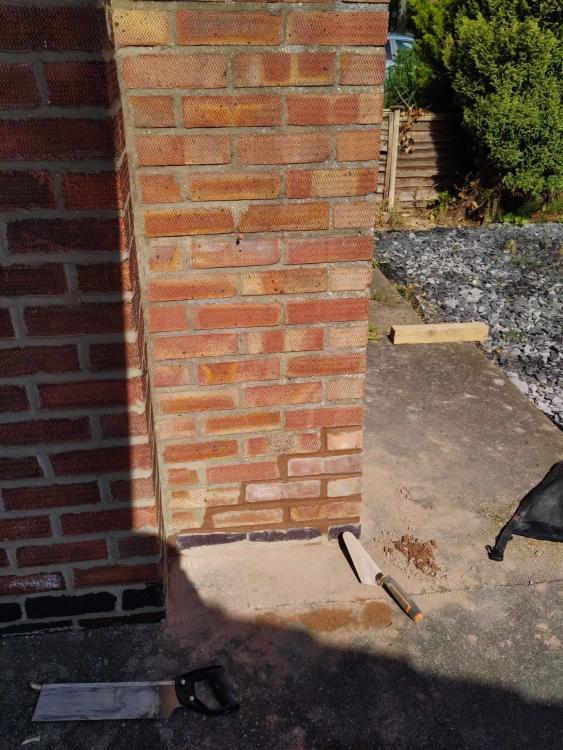Leaderboard
Popular Content
Showing content with the highest reputation on 07/19/23 in all areas
-
I want it replaced. Given all the shit I have had to sort out because of their incompetence I’m not accepting something that could be fixed.2 points
-
Demo and rebuild! Its the only way😬.2 points
-
Reckon I've got it! Again more by luck than judgement, but I did change the order of the bends pulled, pulled the bend by the wall first. It's all loose fittings at the minute as I'm trying to do all the prep work ready to be fixed and pressed once that cupboard is skimmed, painted and floor down and cylinder in.2 points
-
It will be difficult to correct later. I'd get it sorted soon as.1 point
-
No. It used to be the case that a garage floor had to be 100mm lower but the rules changed a few years ago. It now only has to slope away from the door between the house (or utility room) and garage. See page 30 paragraph 5.5.. https://assets.publishing.service.gov.uk/government/uploads/system/uploads/attachment_data/file/485420/BR_PDF_AD_B1_2013.pdf I note there is no minimum slope specified but your BCO might want you to show that any spilt liquids flow away from the door.1 point
-
1 point
-
Flow screeds are usually fine without a mat 80% of the fllow screed that I tile have no matting Usually tiled within a week of being laid They tend to be commercial so no UFH The others tend to be one off builds with UFH and are that spooked by YouTube They go for Ditra As a tiling business you would be surprised how little say I have on the jobs we do I’ve just laid the screed on ours Bit had I gone for flo like I originally intended I wouldn’t have used matting1 point
-
Expansion isn't a problem, contraction is, mostly for the first month when the ecreed is changing chemically, and drying. After that, in real life, the screed warms a little and cools a little and really shouldn't move much, and tiles will move with it if you have allowed expansion gaps.1 point
-
The screed might not crack but large porcelain tiles will expand at a slightly different rate. I also laid 800mm tiles on Anhydrous screed and wasn’t going to use a mat but decided to in the end. That’s just my experience, @nod is the real expert!1 point
-
Separate issues; moisture, adhesion and movement. No doubt it will be dry after 3 years. Any remaining laitance will be fairly obvious and easily removed. A decoupling mat is still recommended to allow thermal expansion without cracking the tiles.1 point
-
I would have thought that any laitance would have worn off through foot traffic and cleaning and your plan seems OK.1 point
-
It is expensive, heavy, difficult to cut, fix and finish and you don't get the benefits of impact resistance and pull-out strength where you would on a wall.1 point
-
I wouldn't choose it. The type of surfacing, at least in a front garden, is a key aspect of 'kerb appeal' which affects the value of the house. To me, imprinted concrete devalues the house as it always seems a poor imitation of what it could have been if the genuine materials been used. I've also seen several that have cracks running through them, which makes them look more fake, apart from being tricky to repair. They can also be slippery when wet. And they still need intermittent cleaning and resealing, so not entirely maintenance free either... If you do choose it, then at least make sure that you have plenty of movement joints.1 point
-
Don’t put anything in it Build a frame around it that is totally independent of the steel Board with 37 mil insulated board Insulating can cause sweating1 point
-
Injection of foam will have zero effect on heat transfer or losses. You need to wrap the column in insulation. Something like 25mm PIR and then plasterboard.1 point
-
Small Air Con Unit known as A2A will be 4 times cheaper to run, provide heating and cooling You can also get a cheap night time tariff and bring it to temperature in this time frame and make it even cheaper to run1 point
-
I'm sure its just me, but i was recently on a site with a £70k window install from a company named quite often on here. The windows were fitted and then a guy came a couple of days later with a van full of what looked like self adhesive draft excluder. He gave me a bit and i had a good squeze etc. Once it was fitted, which was basically done with a flat filling blade, i thought it looked shite. The windows were in a light green, the brickwork red. The 10mm + wide tape looked shocking. A week later it still hadn't expanded to meet the wobbly hand made bricks down either side of the windows. IMO how is that an effective air seal. I will be doing my usual. Sealing all around the front with a 10mm deep frame sealer. Covering that with a 3mm thick glued on plastic strip, matching the window. Filled from behind with foam. Foam cut back, and another bead of silicon around the inside. This is covered on the inside by the plasterboard, and skim. I know it's not the "right way", but works for me. I have got great airtest results with this method. Air sealing tape, and that expanding draft excluder cost 1/2 as much as the bloody windows. Chances are that cheap (not that anything is cheap these day) UPVC windows will leak anyway. This post is @pocster 's chance to call me a bodger. It will make a change from me having a go at him.1 point
-
Personally I would have put them in short lengths of flexible conduit. You can still do this by splitting the lengths and snapping them on.1 point
-
We are Airbnbing... Need to remortgage!1 point
-
1 point
-
Heh, I did a small repair on my sister's brick-built porch made of "london brick" back in May, which I think are the same thing. To add to the varieties you've researched here, the original work was done so that the frogs were facing each other - i.e. you got a diamond-shaped void filled with mortar every two courses. I assume it's like this all the way up the porch. I was not expecting that! The diamonds came out of the bricks very easily, so I decided to re-use them, copying the original method. It was an absolute pig to get the "down" frogs filled when I was replicating it (I had/have no idea what is correct, of coursE). Oh, and these bricks also had two different face textures - smooth vs. wavy imprints. I was focused enough on the frog situation that I didn't notice that and put them all in back-to-front 😬. My sister was kind enough not to insist that I re-do it. It's a world away from your bigger projects, but I enjoyed reading your research and thought this real-world application might amuse you. Have some before/after pics! You can see a bit of spalling on a few of them too 🤷♀️1 point
-
That I don’t know, however my brother in law had a resin drive done on another house and he pointed out a couple of areas where people with power steering had torn the surface (steering without moving), he was not very impressed.1 point
-
https://www.eclisse.co.uk/blog/how-to-guide-how-to-remove-the-door-from-an-eclisse-classic-pocket-door-system/ maybe this is why Eclisse are the bees knees for pocket doors?1 point
-
I understand your pain. I will therefore NOT outline the things that really get to me, but perhaps don't really matter, or you might start seeing them. In case this discussion doesn't continue to its conclusion: the secret to disguising a mismatch is to draw the eye away from the difference. I confess to putting a down-pipe along the interface of 2 slightly differently shaded wall panels. With a gap, it becomes indistinguishable. You already have the substantial jamb otherwise it would show more clearly. You will have seen the illusions of 'what colours are this dress' and red tomato pictures that are really grey. We see what we expect to see. If you end up with the 'problem' outstanding, then having a feature in front of it will break up and reduce the mass. Bird (red squirrel) feeder, chair, shrub? The colour of the feature will also make a difference, but that may require experiment....but I'm thinking another shade of grey-blue.1 point
-
Clearly this window and it is a different coating that has been used.1 point
-
Partial underpinning / soil stabilisation raises new issues. You need the entire building to act as one structural element for it to remain stable and crack-free. There's a risk that the part of the building that has been underpinned swaps from being the least-well supported part of the building to the best-supported part, which could still cause differential movement. That's not to say that it should never be done, but it does mean that whoever is designing the solution needs to have carried out a full investigation first. Personally I'd be wanting an independent structural engineer to be doing that, not a contractor.1 point
-
I like it. if i was going to buy it, i would buy it on the basis that i might not be able to extend it. It would do for me and the wife. Nice bit of grounds to create a nice garden, and permission for a garage for me to play with an old car. I would then get pally with the conservation officer, and try and get him round. Talk about what might be acceptable. If you can get him/her onside planning will be forthcoming. So basically, if you buy it, be prepared to live with it as it is.1 point
-
Only for supply and fit - there has to be an element of labour included for zero rating.1 point
-
Already had that problem with another duct! We managed to drag all of that out and pushed the cable through. Got the cobra through and a pull cord. I’m not convinced I’ll get this 35mm SWA cable through this! Certainly not on my own.0 points
-
0 points
-
Multi-finish every time afaic. I've only ever had one spread ask me to take the MF back and get BF, as he was older than Jesus, set in his ways, and refused to use MF on new PB's0 points
-
@CloGanga, you also need a good family therapist or, worst case scenario, a good divorce lawyer. (Read my driveway story if you are confused.) But more seriously, given your driveway will be flat I don’t see an issue with gravel. If you go for the larger size stones (14mm to 20mm) they will be heavy enough that they shouldn’t move around much.0 points
This leaderboard is set to London/GMT+01:00















